Yunjia Xi
Superplatforms Have to Attack AI Agents
May 23, 2025Abstract:Over the past decades, superplatforms, digital companies that integrate a vast range of third-party services and applications into a single, unified ecosystem, have built their fortunes on monopolizing user attention through targeted advertising and algorithmic content curation. Yet the emergence of AI agents driven by large language models (LLMs) threatens to upend this business model. Agents can not only free user attention with autonomy across diverse platforms and therefore bypass the user-attention-based monetization, but might also become the new entrance for digital traffic. Hence, we argue that superplatforms have to attack AI agents to defend their centralized control of digital traffic entrance. Specifically, we analyze the fundamental conflict between user-attention-based monetization and agent-driven autonomy through the lens of our gatekeeping theory. We show how AI agents can disintermediate superplatforms and potentially become the next dominant gatekeepers, thereby forming the urgent necessity for superplatforms to proactively constrain and attack AI agents. Moreover, we go through the potential technologies for superplatform-initiated attacks, covering a brand-new, unexplored technical area with unique challenges. We have to emphasize that, despite our position, this paper does not advocate for adversarial attacks by superplatforms on AI agents, but rather offers an envisioned trend to highlight the emerging tensions between superplatforms and AI agents. Our aim is to raise awareness and encourage critical discussion for collaborative solutions, prioritizing user interests and perserving the openness of digital ecosystems in the age of AI agents.
The Real Barrier to LLM Agent Usability is Agentic ROI
May 23, 2025Abstract:Large Language Model (LLM) agents represent a promising shift in human-AI interaction, moving beyond passive prompt-response systems to autonomous agents capable of reasoning, planning, and goal-directed action. Despite the widespread application in specialized, high-effort tasks like coding and scientific research, we highlight a critical usability gap in high-demand, mass-market applications. This position paper argues that the limited real-world adoption of LLM agents stems not only from gaps in model capabilities, but also from a fundamental tradeoff between the value an agent can provide and the costs incurred during real-world use. Hence, we call for a shift from solely optimizing model performance to a broader, utility-driven perspective: evaluating agents through the lens of the overall agentic return on investment (Agent ROI). By identifying key factors that determine Agentic ROI--information quality, agent time, and cost--we posit a zigzag development trajectory in optimizing agentic ROI: first scaling up to improve the information quality, then scaling down to minimize the time and cost. We outline the roadmap across different development stages to bridge the current usability gaps, aiming to make LLM agents truly scalable, accessible, and effective in real-world contexts.
InfoDeepSeek: Benchmarking Agentic Information Seeking for Retrieval-Augmented Generation
May 21, 2025Abstract:Retrieval-Augmented Generation (RAG) enhances large language models (LLMs) by grounding responses with retrieved information. As an emerging paradigm, Agentic RAG further enhances this process by introducing autonomous LLM agents into the information seeking process. However, existing benchmarks fall short in evaluating such systems, as they are confined to a static retrieval environment with a fixed, limited corpus} and simple queries that fail to elicit agentic behavior. Moreover, their evaluation protocols assess information seeking effectiveness by pre-defined gold sets of documents, making them unsuitable for the open-ended and dynamic nature of real-world web environments. To bridge this gap, we present InfoDeepSeek, a new benchmark with challenging questions designed for assessing agentic information seeking in real-world, dynamic web environments. We propose a systematic methodology for constructing challenging queries satisfying the criteria of determinacy, difficulty, and diversity. Based on this, we develop the first evaluation framework tailored to dynamic agentic information seeking, including fine-grained metrics about the accuracy, utility, and compactness of information seeking outcomes. Through extensive experiments across LLMs, search engines, and question types, InfoDeepSeek reveals nuanced agent behaviors and offers actionable insights for future research.
Bursting Filter Bubble: Enhancing Serendipity Recommendations with Aligned Large Language Models
Feb 19, 2025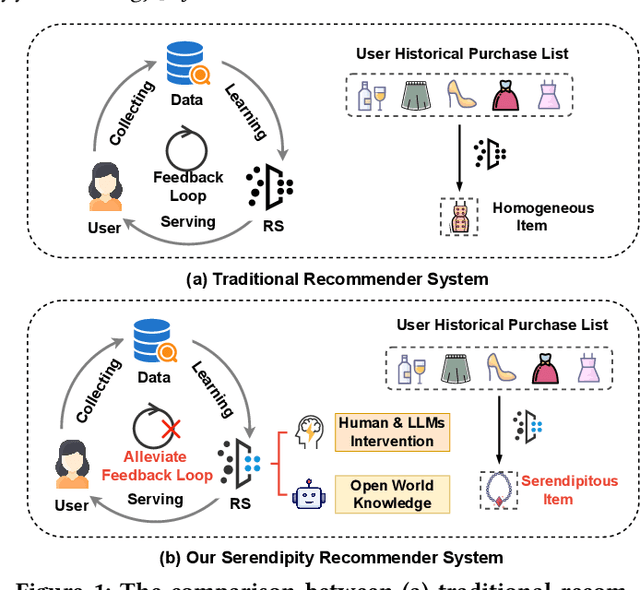

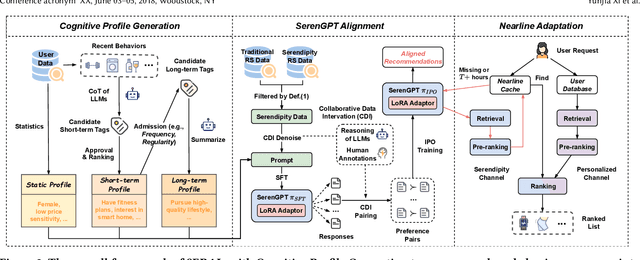
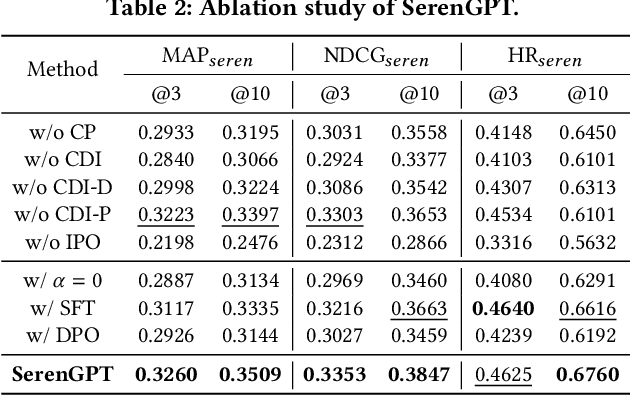
Abstract:Recommender systems (RSs) often suffer from the feedback loop phenomenon, e.g., RSs are trained on data biased by their recommendations. This leads to the filter bubble effect that reinforces homogeneous content and reduces user satisfaction. To this end, serendipity recommendations, which offer unexpected yet relevant items, are proposed. Recently, large language models (LLMs) have shown potential in serendipity prediction due to their extensive world knowledge and reasoning capabilities. However, they still face challenges in aligning serendipity judgments with human assessments, handling long user behavior sequences, and meeting the latency requirements of industrial RSs. To address these issues, we propose SERAL (Serendipity Recommendations with Aligned Large Language Models), a framework comprising three stages: (1) Cognition Profile Generation to compress user behavior into multi-level profiles; (2) SerenGPT Alignment to align serendipity judgments with human preferences using enriched training data; and (3) Nearline Adaptation to integrate SerenGPT into industrial RSs pipelines efficiently. Online experiments demonstrate that SERAL improves exposure ratio (PVR), clicks, and transactions of serendipitous items by 5.7%, 29.56%, and 27.6%, enhancing user experience without much impact on overall revenue. Now, it has been fully deployed in the "Guess What You Like" of the Taobao App homepage.
LIBER: Lifelong User Behavior Modeling Based on Large Language Models
Nov 22, 2024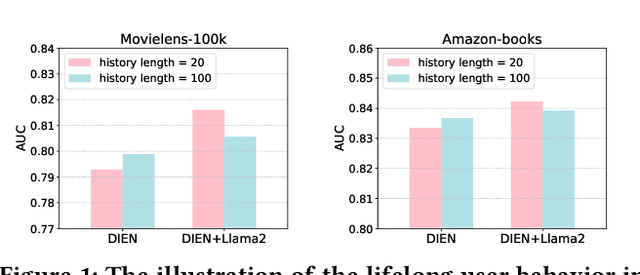
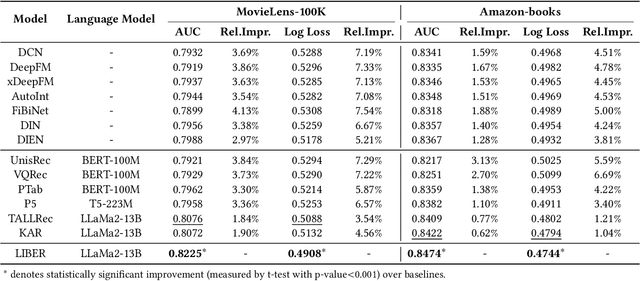
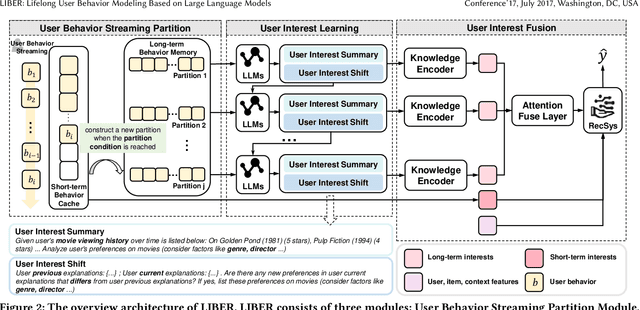

Abstract:CTR prediction plays a vital role in recommender systems. Recently, large language models (LLMs) have been applied in recommender systems due to their emergence abilities. While leveraging semantic information from LLMs has shown some improvements in the performance of recommender systems, two notable limitations persist in these studies. First, LLM-enhanced recommender systems encounter challenges in extracting valuable information from lifelong user behavior sequences within textual contexts for recommendation tasks. Second, the inherent variability in human behaviors leads to a constant stream of new behaviors and irregularly fluctuating user interests. This characteristic imposes two significant challenges on existing models. On the one hand, it presents difficulties for LLMs in effectively capturing the dynamic shifts in user interests within these sequences, and on the other hand, there exists the issue of substantial computational overhead if the LLMs necessitate recurrent calls upon each update to the user sequences. In this work, we propose Lifelong User Behavior Modeling (LIBER) based on large language models, which includes three modules: (1) User Behavior Streaming Partition (UBSP), (2) User Interest Learning (UIL), and (3) User Interest Fusion (UIF). Initially, UBSP is employed to condense lengthy user behavior sequences into shorter partitions in an incremental paradigm, facilitating more efficient processing. Subsequently, UIL leverages LLMs in a cascading way to infer insights from these partitions. Finally, UIF integrates the textual outputs generated by the aforementioned processes to construct a comprehensive representation, which can be incorporated by any recommendation model to enhance performance. LIBER has been deployed on Huawei's music recommendation service and achieved substantial improvements in users' play count and play time by 3.01% and 7.69%.
Beyond Positive History: Re-ranking with List-level Hybrid Feedback
Oct 28, 2024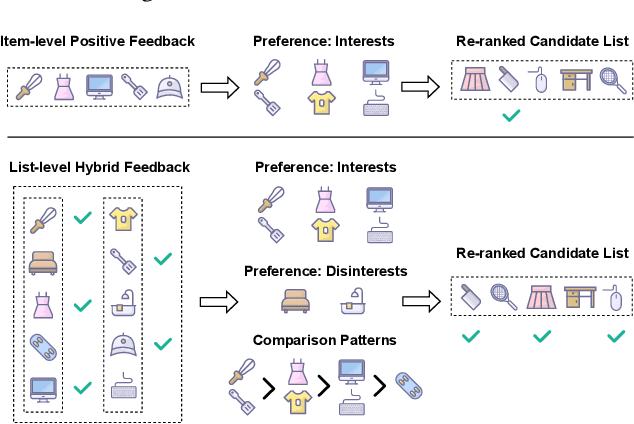
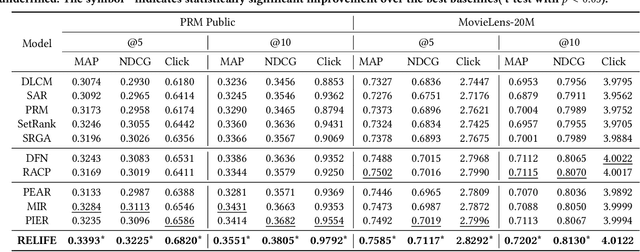
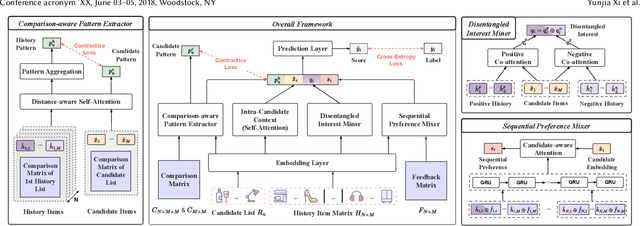

Abstract:As the last stage of recommender systems, re-ranking generates a re-ordered list that aligns with the user's preference. However, previous works generally focus on item-level positive feedback as history (e.g., only clicked items) and ignore that users provide positive or negative feedback on items in the entire list. This list-level hybrid feedback can reveal users' holistic preferences and reflect users' comparison behavior patterns manifesting within a list. Such patterns could predict user behaviors on candidate lists, thus aiding better re-ranking. Despite appealing benefits, extracting and integrating preferences and behavior patterns from list-level hybrid feedback into re-ranking multiple items remains challenging. To this end, we propose Re-ranking with List-level Hybrid Feedback (dubbed RELIFE). It captures user's preferences and behavior patterns with three modules: a Disentangled Interest Miner to disentangle the user's preferences into interests and disinterests, a Sequential Preference Mixer to learn users' entangled preferences considering the context of feedback, and a Comparison-aware Pattern Extractor to capture user's behavior patterns within each list. Moreover, for better integration of patterns, contrastive learning is adopted to align the behavior patterns of candidate and historical lists. Extensive experiments show that RELIFE significantly outperforms SOTA re-ranking baselines.
A Survey on Diffusion Models for Recommender Systems
Sep 08, 2024Abstract:While traditional recommendation techniques have made significant strides in the past decades, they still suffer from limited generalization performance caused by factors like inadequate collaborative signals, weak latent representations, and noisy data. In response, diffusion models (DMs) have emerged as promising solutions for recommender systems due to their robust generative capabilities, solid theoretical foundations, and improved training stability. To this end, in this paper, we present the first comprehensive survey on diffusion models for recommendation, and draw a bird's-eye view from the perspective of the whole pipeline in real-world recommender systems. We systematically categorize existing research works into three primary domains: (1) diffusion for data engineering & encoding, focusing on data augmentation and representation enhancement; (2) diffusion as recommender models, employing diffusion models to directly estimate user preferences and rank items; and (3) diffusion for content presentation, utilizing diffusion models to generate personalized content such as fashion and advertisement creatives. Our taxonomy highlights the unique strengths of diffusion models in capturing complex data distributions and generating high-quality, diverse samples that closely align with user preferences. We also summarize the core characteristics of the adapting diffusion models for recommendation, and further identify key areas for future exploration, which helps establish a roadmap for researchers and practitioners seeking to advance recommender systems through the innovative application of diffusion models. To further facilitate the research community of recommender systems based on diffusion models, we actively maintain a GitHub repository for papers and other related resources in this rising direction https://github.com/CHIANGEL/Awesome-Diffusion-for-RecSys.
Efficient and Deployable Knowledge Infusion for Open-World Recommendations via Large Language Models
Aug 20, 2024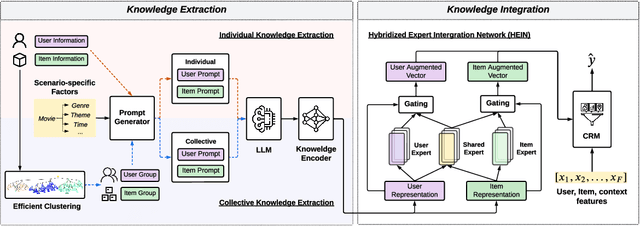

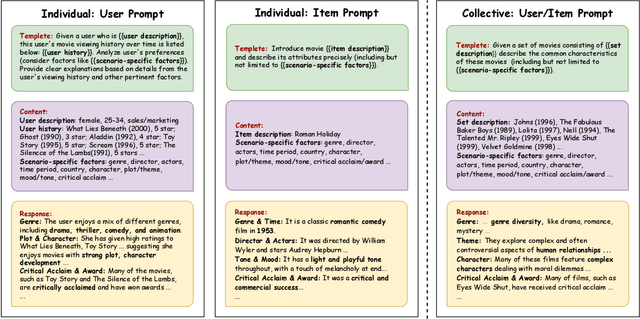

Abstract:Recommender systems (RSs) play a pervasive role in today's online services, yet their closed-loop nature constrains their access to open-world knowledge. Recently, large language models (LLMs) have shown promise in bridging this gap. However, previous attempts to directly implement LLMs as recommenders fall short in meeting the requirements of industrial RSs, particularly in terms of online inference latency and offline resource efficiency. Thus, we propose REKI to acquire two types of external knowledge about users and items from LLMs. Specifically, we introduce factorization prompting to elicit accurate knowledge reasoning on user preferences and items. We develop individual knowledge extraction and collective knowledge extraction tailored for different scales of scenarios, effectively reducing offline resource consumption. Subsequently, generated knowledge undergoes efficient transformation and condensation into augmented vectors through a hybridized expert-integrated network, ensuring compatibility. The obtained vectors can then be used to enhance any conventional recommendation model. We also ensure efficient inference by preprocessing and prestoring the knowledge from LLMs. Experiments demonstrate that REKI outperforms state-of-the-art baselines and is compatible with lots of recommendation algorithms and tasks. Now, REKI has been deployed to Huawei's news and music recommendation platforms and gained a 7% and 1.99% improvement during the online A/B test.
A Decoding Acceleration Framework for Industrial Deployable LLM-based Recommender Systems
Aug 11, 2024Abstract:Recently, increasing attention has been paid to LLM-based recommender systems, but their deployment is still under exploration in the industry. Most deployments utilize LLMs as feature enhancers, generating augmentation knowledge in the offline stage. However, in recommendation scenarios, involving numerous users and items, even offline generation with LLMs consumes considerable time and resources. This generation inefficiency stems from the autoregressive nature of LLMs, and a promising direction for acceleration is speculative decoding, a Draft-then-Verify paradigm that increases the number of generated tokens per decoding step. In this paper, we first identify that recommendation knowledge generation is suitable for retrieval-based speculative decoding. Then, we discern two characteristics: (1) extensive items and users in RSs bring retrieval inefficiency, and (2) RSs exhibit high diversity tolerance for text generated by LLMs. Based on the above insights, we propose a Decoding Acceleration Framework for LLM-based Recommendation (dubbed DARE), with Customized Retrieval Pool to improve retrieval efficiency and Relaxed Verification to increase the acceptance rate of draft tokens, respectively. Extensive experiments demonstrate that DARE achieves a 3-5x speedup and is compatible with various frameworks and backbone LLMs. DARE has also been deployed to online advertising scenarios within a large-scale commercial environment, achieving a 3.45x speedup while maintaining the downstream performance.
MemoCRS: Memory-enhanced Sequential Conversational Recommender Systems with Large Language Models
Jul 06, 2024



Abstract:Conversational recommender systems (CRSs) aim to capture user preferences and provide personalized recommendations through multi-round natural language dialogues. However, most existing CRS models mainly focus on dialogue comprehension and preferences mining from the current dialogue session, overlooking user preferences in historical dialogue sessions. The preferences embedded in the user's historical dialogue sessions and the current session exhibit continuity and sequentiality, and we refer to CRSs with this characteristic as sequential CRSs. In this work, we leverage memory-enhanced LLMs to model the preference continuity, primarily focusing on addressing two key issues: (1) redundancy and noise in historical dialogue sessions, and (2) the cold-start users problem. To this end, we propose a Memory-enhanced Conversational Recommender System Framework with Large Language Models (dubbed MemoCRS) consisting of user-specific memory and general memory. User-specific memory is tailored to each user for their personalized interests and implemented by an entity-based memory bank to refine preferences and retrieve relevant memory, thereby reducing the redundancy and noise of historical sessions. The general memory, encapsulating collaborative knowledge and reasoning guidelines, can provide shared knowledge for users, especially cold-start users. With the two kinds of memory, LLMs are empowered to deliver more precise and tailored recommendations for each user. Extensive experiments on both Chinese and English datasets demonstrate the effectiveness of MemoCRS.
 Add to Chrome
Add to Chrome Add to Firefox
Add to Firefox Add to Edge
Add to Edge